Leadership, Culture, & Innovation in UK Beauty Salons: A Study
VerifiedAdded on 2023/06/13
|8
|2000
|310
Project
AI Summary
This research project investigates the impact of leadership on organizational culture and innovation within international businesses, specifically focusing on UK beauty salons, using NailSpa as a case study. The project aims to understand the relationship between leadership, organizational culture, and innovation through a mixed-methods approach, utilizing both qualitative and quantitative data collection techniques. The research employs interpretivism and positivism philosophies alongside inductive and deductive approaches to analyze primary data collected via questionnaires from NailSpa employees and secondary data from books and articles. The study addresses key research questions concerning the concept of international business leadership, its impact on organizational culture, and its role in fostering innovation within the beauty salon context. The ethical considerations of the research, including participant recruitment, informed consent, data confidentiality, and protection of the researcher, are also addressed.
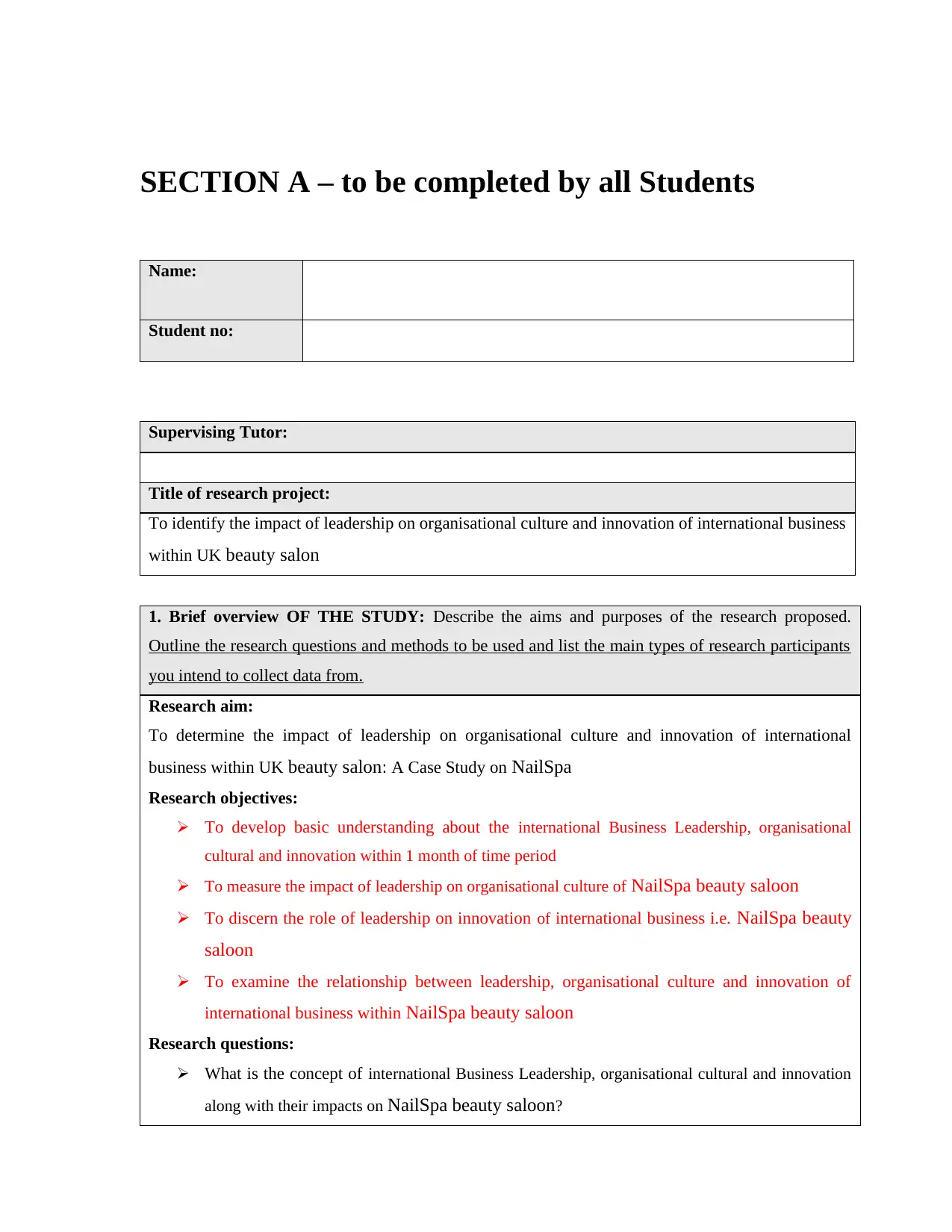
SECTION A – to be completed by all Students
Name:
Student no:
Supervising Tutor:
Title of research project:
To identify the impact of leadership on organisational culture and innovation of international business
within UK beauty salon
1. Brief overview OF THE STUDY: Describe the aims and purposes of the research proposed.
Outline the research questions and methods to be used and list the main types of research participants
you intend to collect data from.
Research aim:
To determine the impact of leadership on organisational culture and innovation of international
business within UK beauty salon: A Case Study on NailSpa
Research objectives:
To develop basic understanding about the international Business Leadership, organisational
cultural and innovation within 1 month of time period
To measure the impact of leadership on organisational culture of NailSpa beauty saloon
To discern the role of leadership on innovation of international business i.e. NailSpa beauty
saloon
To examine the relationship between leadership, organisational culture and innovation of
international business within NailSpa beauty saloon
Research questions:
What is the concept of international Business Leadership, organisational cultural and innovation
along with their impacts on NailSpa beauty saloon?
Name:
Student no:
Supervising Tutor:
Title of research project:
To identify the impact of leadership on organisational culture and innovation of international business
within UK beauty salon
1. Brief overview OF THE STUDY: Describe the aims and purposes of the research proposed.
Outline the research questions and methods to be used and list the main types of research participants
you intend to collect data from.
Research aim:
To determine the impact of leadership on organisational culture and innovation of international
business within UK beauty salon: A Case Study on NailSpa
Research objectives:
To develop basic understanding about the international Business Leadership, organisational
cultural and innovation within 1 month of time period
To measure the impact of leadership on organisational culture of NailSpa beauty saloon
To discern the role of leadership on innovation of international business i.e. NailSpa beauty
saloon
To examine the relationship between leadership, organisational culture and innovation of
international business within NailSpa beauty saloon
Research questions:
What is the concept of international Business Leadership, organisational cultural and innovation
along with their impacts on NailSpa beauty saloon?
Paraphrase This Document
Need a fresh take? Get an instant paraphrase of this document with our AI Paraphraser
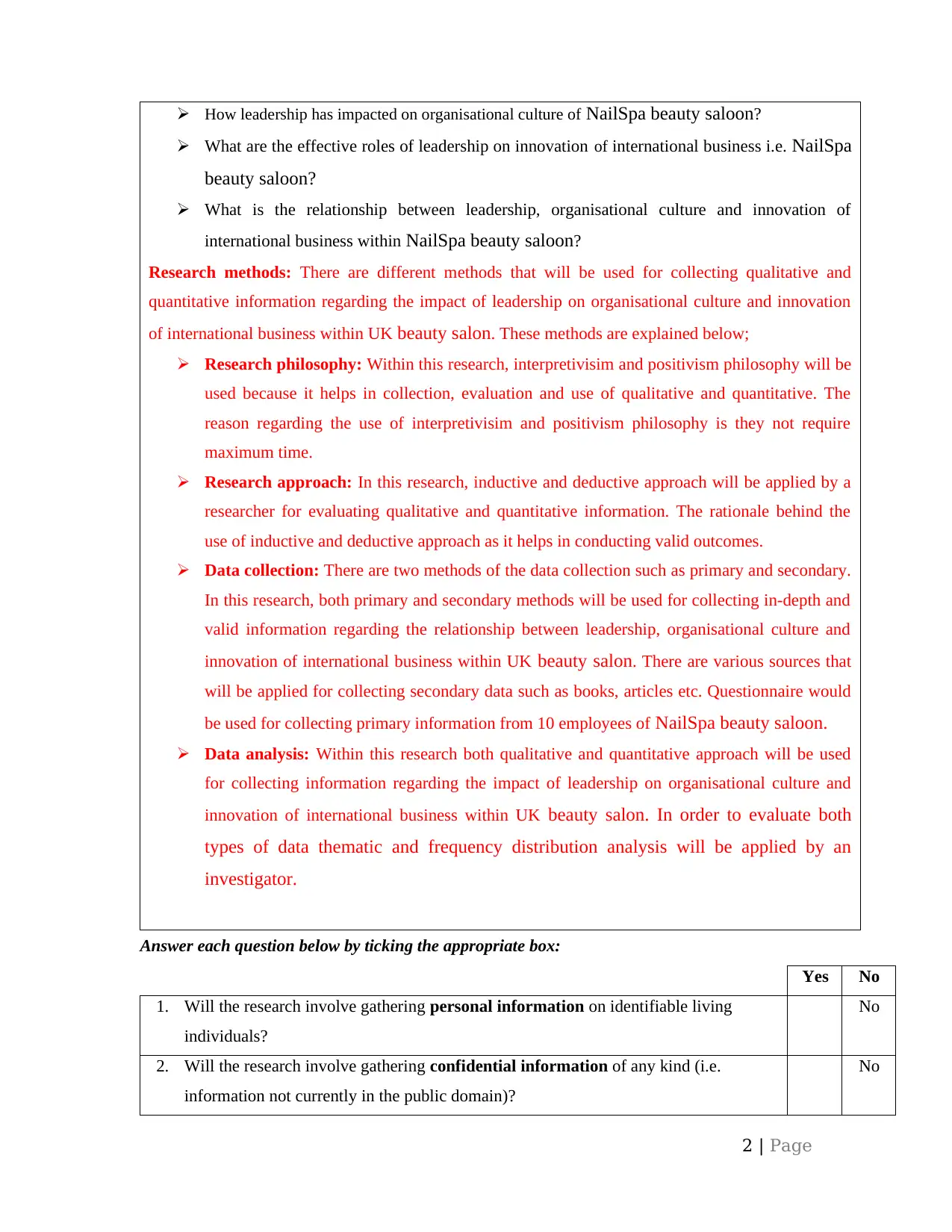
How leadership has impacted on organisational culture of NailSpa beauty saloon?
What are the effective roles of leadership on innovation of international business i.e. NailSpa
beauty saloon?
What is the relationship between leadership, organisational culture and innovation of
international business within NailSpa beauty saloon?
Research methods: There are different methods that will be used for collecting qualitative and
quantitative information regarding the impact of leadership on organisational culture and innovation
of international business within UK beauty salon. These methods are explained below;
Research philosophy: Within this research, interpretivisim and positivism philosophy will be
used because it helps in collection, evaluation and use of qualitative and quantitative. The
reason regarding the use of interpretivisim and positivism philosophy is they not require
maximum time.
Research approach: In this research, inductive and deductive approach will be applied by a
researcher for evaluating qualitative and quantitative information. The rationale behind the
use of inductive and deductive approach as it helps in conducting valid outcomes.
Data collection: There are two methods of the data collection such as primary and secondary.
In this research, both primary and secondary methods will be used for collecting in-depth and
valid information regarding the relationship between leadership, organisational culture and
innovation of international business within UK beauty salon. There are various sources that
will be applied for collecting secondary data such as books, articles etc. Questionnaire would
be used for collecting primary information from 10 employees of NailSpa beauty saloon.
Data analysis: Within this research both qualitative and quantitative approach will be used
for collecting information regarding the impact of leadership on organisational culture and
innovation of international business within UK beauty salon. In order to evaluate both
types of data thematic and frequency distribution analysis will be applied by an
investigator.
Answer each question below by ticking the appropriate box:
Yes No
1. Will the research involve gathering personal information on identifiable living
individuals?
No
2. Will the research involve gathering confidential information of any kind (i.e.
information not currently in the public domain)?
No
2 | Page
What are the effective roles of leadership on innovation of international business i.e. NailSpa
beauty saloon?
What is the relationship between leadership, organisational culture and innovation of
international business within NailSpa beauty saloon?
Research methods: There are different methods that will be used for collecting qualitative and
quantitative information regarding the impact of leadership on organisational culture and innovation
of international business within UK beauty salon. These methods are explained below;
Research philosophy: Within this research, interpretivisim and positivism philosophy will be
used because it helps in collection, evaluation and use of qualitative and quantitative. The
reason regarding the use of interpretivisim and positivism philosophy is they not require
maximum time.
Research approach: In this research, inductive and deductive approach will be applied by a
researcher for evaluating qualitative and quantitative information. The rationale behind the
use of inductive and deductive approach as it helps in conducting valid outcomes.
Data collection: There are two methods of the data collection such as primary and secondary.
In this research, both primary and secondary methods will be used for collecting in-depth and
valid information regarding the relationship between leadership, organisational culture and
innovation of international business within UK beauty salon. There are various sources that
will be applied for collecting secondary data such as books, articles etc. Questionnaire would
be used for collecting primary information from 10 employees of NailSpa beauty saloon.
Data analysis: Within this research both qualitative and quantitative approach will be used
for collecting information regarding the impact of leadership on organisational culture and
innovation of international business within UK beauty salon. In order to evaluate both
types of data thematic and frequency distribution analysis will be applied by an
investigator.
Answer each question below by ticking the appropriate box:
Yes No
1. Will the research involve gathering personal information on identifiable living
individuals?
No
2. Will the research involve gathering confidential information of any kind (i.e.
information not currently in the public domain)?
No
2 | Page
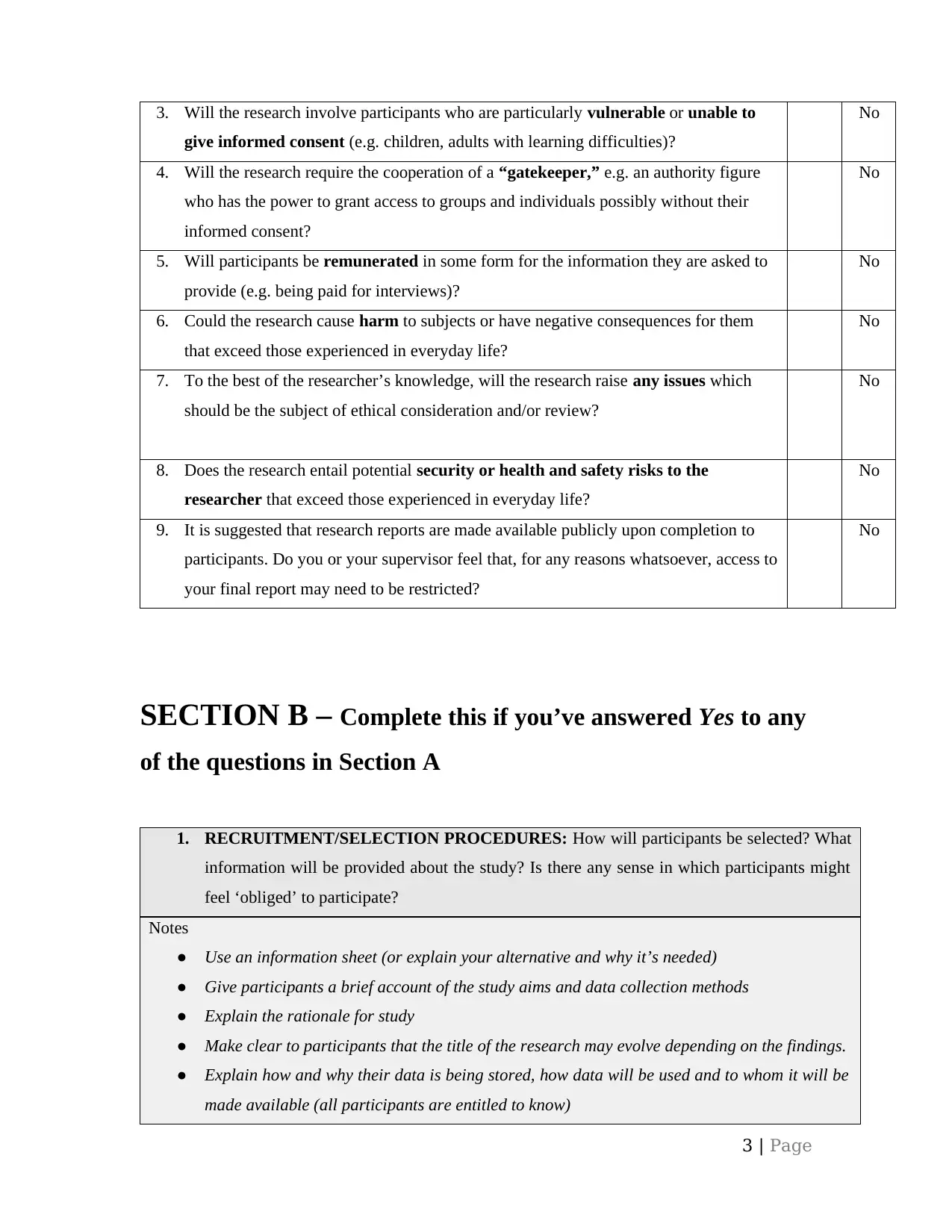
3. Will the research involve participants who are particularly vulnerable or unable to
give informed consent (e.g. children, adults with learning difficulties)?
No
4. Will the research require the cooperation of a “gatekeeper,” e.g. an authority figure
who has the power to grant access to groups and individuals possibly without their
informed consent?
No
5. Will participants be remunerated in some form for the information they are asked to
provide (e.g. being paid for interviews)?
No
6. Could the research cause harm to subjects or have negative consequences for them
that exceed those experienced in everyday life?
No
7. To the best of the researcher’s knowledge, will the research raise any issues which
should be the subject of ethical consideration and/or review?
No
8. Does the research entail potential security or health and safety risks to the
researcher that exceed those experienced in everyday life?
No
9. It is suggested that research reports are made available publicly upon completion to
participants. Do you or your supervisor feel that, for any reasons whatsoever, access to
your final report may need to be restricted?
No
SECTION B – Complete this if you’ve answered Yes to any
of the questions in Section A
1. RECRUITMENT/SELECTION PROCEDURES: How will participants be selected? What
information will be provided about the study? Is there any sense in which participants might
feel ‘obliged’ to participate?
Notes
● Use an information sheet (or explain your alternative and why it’s needed)
● Give participants a brief account of the study aims and data collection methods
● Explain the rationale for study
● Make clear to participants that the title of the research may evolve depending on the findings.
● Explain how and why their data is being stored, how data will be used and to whom it will be
made available (all participants are entitled to know)
3 | Page
give informed consent (e.g. children, adults with learning difficulties)?
No
4. Will the research require the cooperation of a “gatekeeper,” e.g. an authority figure
who has the power to grant access to groups and individuals possibly without their
informed consent?
No
5. Will participants be remunerated in some form for the information they are asked to
provide (e.g. being paid for interviews)?
No
6. Could the research cause harm to subjects or have negative consequences for them
that exceed those experienced in everyday life?
No
7. To the best of the researcher’s knowledge, will the research raise any issues which
should be the subject of ethical consideration and/or review?
No
8. Does the research entail potential security or health and safety risks to the
researcher that exceed those experienced in everyday life?
No
9. It is suggested that research reports are made available publicly upon completion to
participants. Do you or your supervisor feel that, for any reasons whatsoever, access to
your final report may need to be restricted?
No
SECTION B – Complete this if you’ve answered Yes to any
of the questions in Section A
1. RECRUITMENT/SELECTION PROCEDURES: How will participants be selected? What
information will be provided about the study? Is there any sense in which participants might
feel ‘obliged’ to participate?
Notes
● Use an information sheet (or explain your alternative and why it’s needed)
● Give participants a brief account of the study aims and data collection methods
● Explain the rationale for study
● Make clear to participants that the title of the research may evolve depending on the findings.
● Explain how and why their data is being stored, how data will be used and to whom it will be
made available (all participants are entitled to know)
3 | Page
⊘ This is a preview!⊘
Do you want full access?
Subscribe today to unlock all pages.

Trusted by 1+ million students worldwide
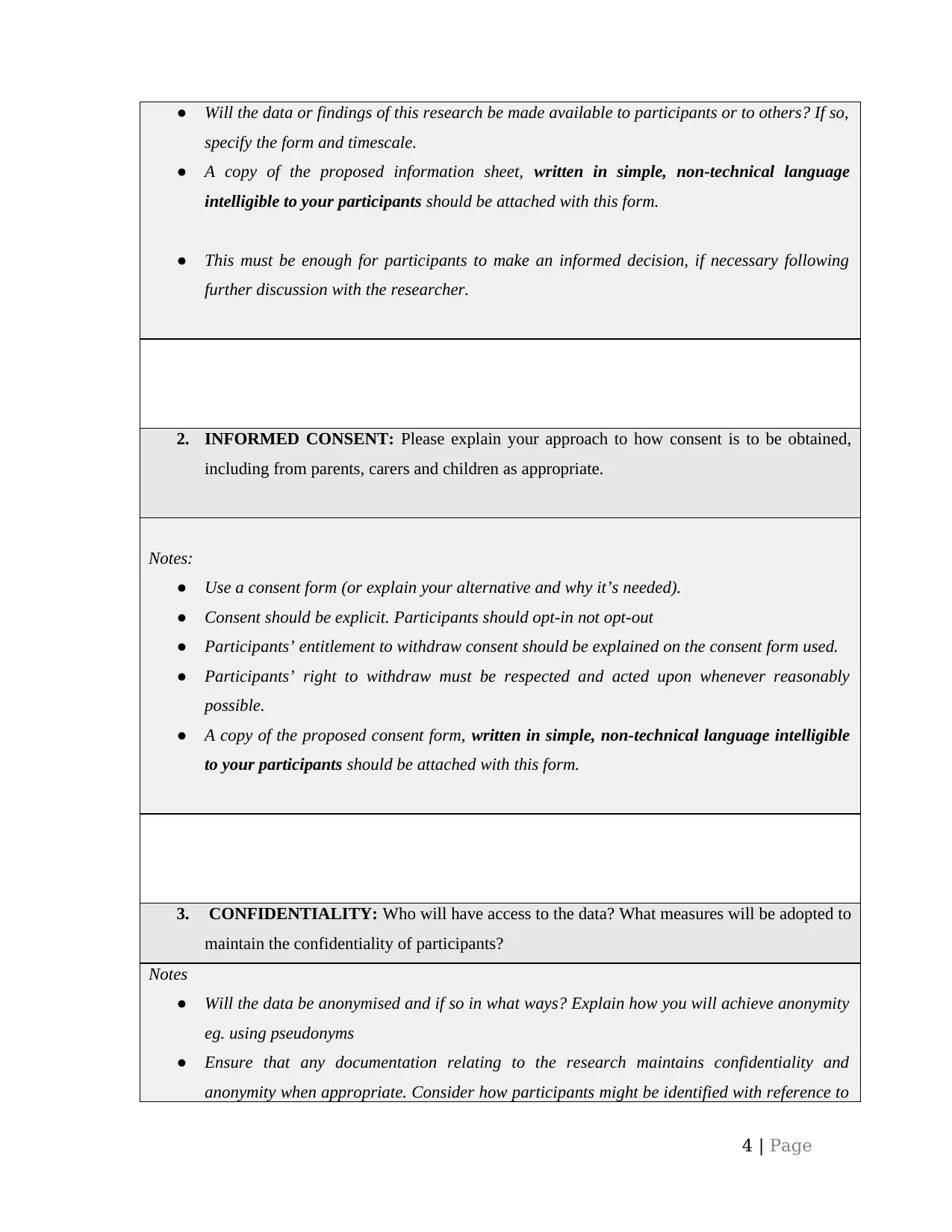
● Will the data or findings of this research be made available to participants or to others? If so,
specify the form and timescale.
● A copy of the proposed information sheet, written in simple, non-technical language
intelligible to your participants should be attached with this form.
● This must be enough for participants to make an informed decision, if necessary following
further discussion with the researcher.
2. INFORMED CONSENT: Please explain your approach to how consent is to be obtained,
including from parents, carers and children as appropriate.
Notes:
● Use a consent form (or explain your alternative and why it’s needed).
● Consent should be explicit. Participants should opt-in not opt-out
● Participants’ entitlement to withdraw consent should be explained on the consent form used.
● Participants’ right to withdraw must be respected and acted upon whenever reasonably
possible.
● A copy of the proposed consent form, written in simple, non-technical language intelligible
to your participants should be attached with this form.
3. CONFIDENTIALITY: Who will have access to the data? What measures will be adopted to
maintain the confidentiality of participants?
Notes
● Will the data be anonymised and if so in what ways? Explain how you will achieve anonymity
eg. using pseudonyms
● Ensure that any documentation relating to the research maintains confidentiality and
anonymity when appropriate. Consider how participants might be identified with reference to
4 | Page
specify the form and timescale.
● A copy of the proposed information sheet, written in simple, non-technical language
intelligible to your participants should be attached with this form.
● This must be enough for participants to make an informed decision, if necessary following
further discussion with the researcher.
2. INFORMED CONSENT: Please explain your approach to how consent is to be obtained,
including from parents, carers and children as appropriate.
Notes:
● Use a consent form (or explain your alternative and why it’s needed).
● Consent should be explicit. Participants should opt-in not opt-out
● Participants’ entitlement to withdraw consent should be explained on the consent form used.
● Participants’ right to withdraw must be respected and acted upon whenever reasonably
possible.
● A copy of the proposed consent form, written in simple, non-technical language intelligible
to your participants should be attached with this form.
3. CONFIDENTIALITY: Who will have access to the data? What measures will be adopted to
maintain the confidentiality of participants?
Notes
● Will the data be anonymised and if so in what ways? Explain how you will achieve anonymity
eg. using pseudonyms
● Ensure that any documentation relating to the research maintains confidentiality and
anonymity when appropriate. Consider how participants might be identified with reference to
4 | Page
Paraphrase This Document
Need a fresh take? Get an instant paraphrase of this document with our AI Paraphraser
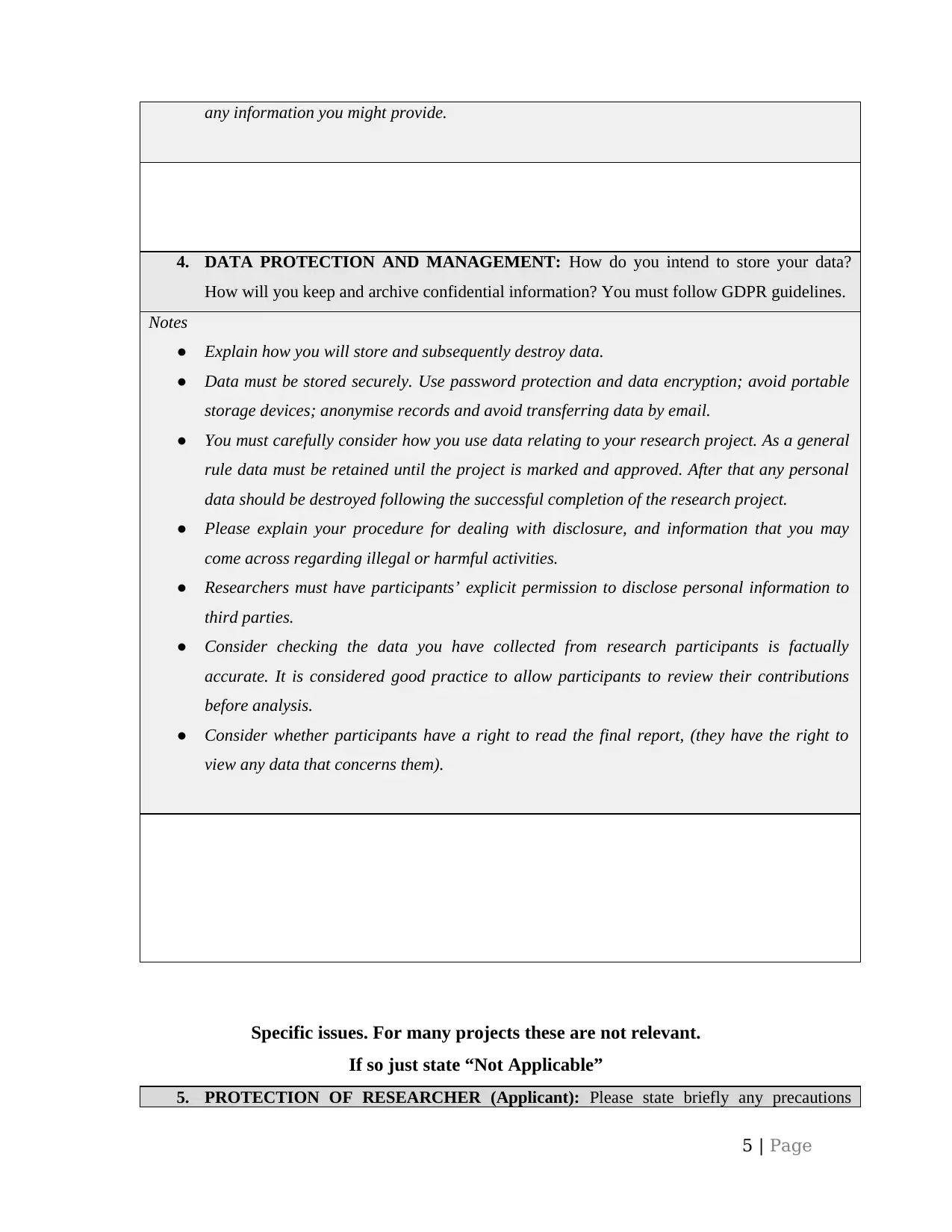
any information you might provide.
4. DATA PROTECTION AND MANAGEMENT: How do you intend to store your data?
How will you keep and archive confidential information? You must follow GDPR guidelines.
Notes
● Explain how you will store and subsequently destroy data.
● Data must be stored securely. Use password protection and data encryption; avoid portable
storage devices; anonymise records and avoid transferring data by email.
● You must carefully consider how you use data relating to your research project. As a general
rule data must be retained until the project is marked and approved. After that any personal
data should be destroyed following the successful completion of the research project.
● Please explain your procedure for dealing with disclosure, and information that you may
come across regarding illegal or harmful activities.
● Researchers must have participants’ explicit permission to disclose personal information to
third parties.
● Consider checking the data you have collected from research participants is factually
accurate. It is considered good practice to allow participants to review their contributions
before analysis.
● Consider whether participants have a right to read the final report, (they have the right to
view any data that concerns them).
Specific issues. For many projects these are not relevant.
If so just state “Not Applicable”
5. PROTECTION OF RESEARCHER (Applicant): Please state briefly any precautions
5 | Page
4. DATA PROTECTION AND MANAGEMENT: How do you intend to store your data?
How will you keep and archive confidential information? You must follow GDPR guidelines.
Notes
● Explain how you will store and subsequently destroy data.
● Data must be stored securely. Use password protection and data encryption; avoid portable
storage devices; anonymise records and avoid transferring data by email.
● You must carefully consider how you use data relating to your research project. As a general
rule data must be retained until the project is marked and approved. After that any personal
data should be destroyed following the successful completion of the research project.
● Please explain your procedure for dealing with disclosure, and information that you may
come across regarding illegal or harmful activities.
● Researchers must have participants’ explicit permission to disclose personal information to
third parties.
● Consider checking the data you have collected from research participants is factually
accurate. It is considered good practice to allow participants to review their contributions
before analysis.
● Consider whether participants have a right to read the final report, (they have the right to
view any data that concerns them).
Specific issues. For many projects these are not relevant.
If so just state “Not Applicable”
5. PROTECTION OF RESEARCHER (Applicant): Please state briefly any precautions
5 | Page
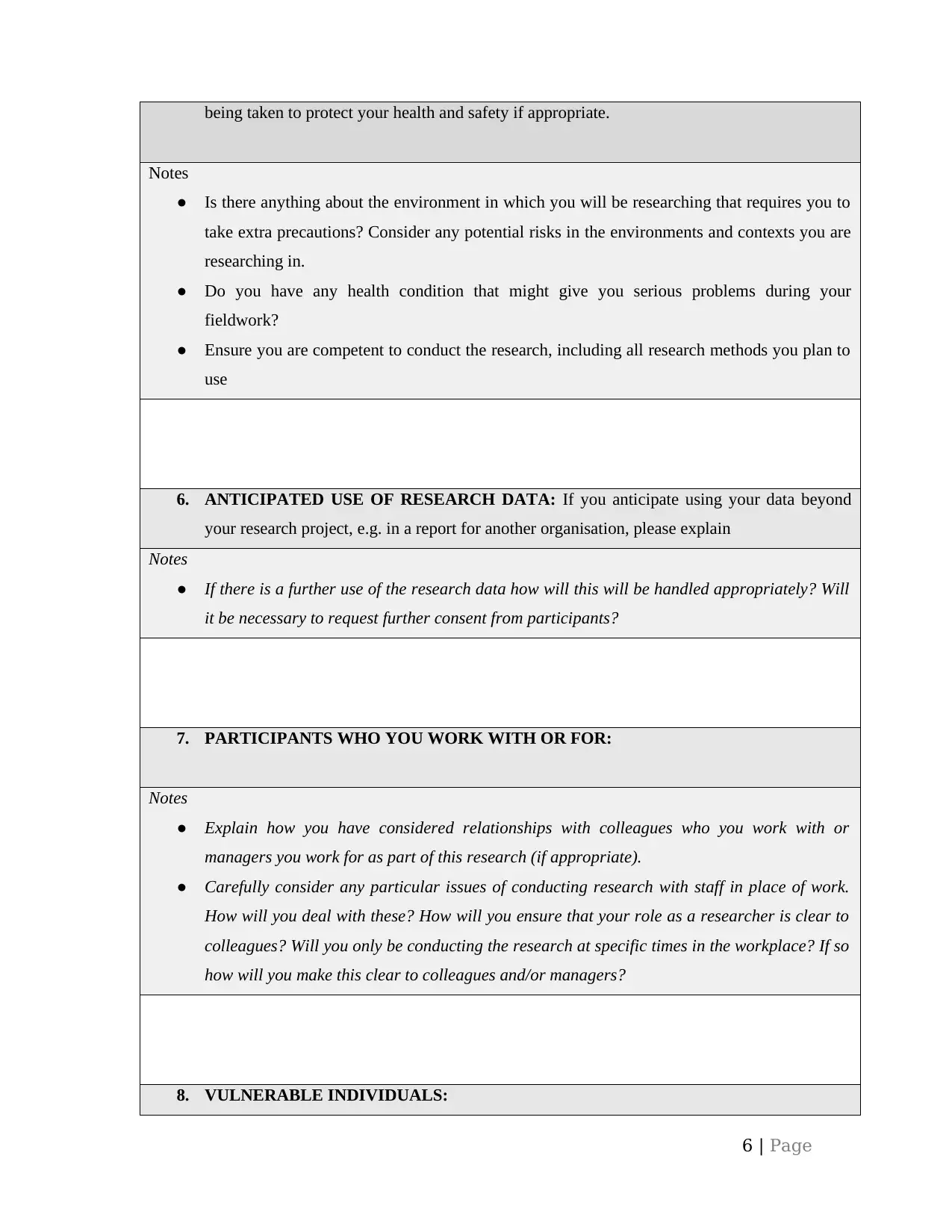
being taken to protect your health and safety if appropriate.
Notes
● Is there anything about the environment in which you will be researching that requires you to
take extra precautions? Consider any potential risks in the environments and contexts you are
researching in.
● Do you have any health condition that might give you serious problems during your
fieldwork?
● Ensure you are competent to conduct the research, including all research methods you plan to
use
6. ANTICIPATED USE OF RESEARCH DATA: If you anticipate using your data beyond
your research project, e.g. in a report for another organisation, please explain
Notes
● If there is a further use of the research data how will this will be handled appropriately? Will
it be necessary to request further consent from participants?
7. PARTICIPANTS WHO YOU WORK WITH OR FOR:
Notes
● Explain how you have considered relationships with colleagues who you work with or
managers you work for as part of this research (if appropriate).
● Carefully consider any particular issues of conducting research with staff in place of work.
How will you deal with these? How will you ensure that your role as a researcher is clear to
colleagues? Will you only be conducting the research at specific times in the workplace? If so
how will you make this clear to colleagues and/or managers?
8. VULNERABLE INDIVIDUALS:
6 | Page
Notes
● Is there anything about the environment in which you will be researching that requires you to
take extra precautions? Consider any potential risks in the environments and contexts you are
researching in.
● Do you have any health condition that might give you serious problems during your
fieldwork?
● Ensure you are competent to conduct the research, including all research methods you plan to
use
6. ANTICIPATED USE OF RESEARCH DATA: If you anticipate using your data beyond
your research project, e.g. in a report for another organisation, please explain
Notes
● If there is a further use of the research data how will this will be handled appropriately? Will
it be necessary to request further consent from participants?
7. PARTICIPANTS WHO YOU WORK WITH OR FOR:
Notes
● Explain how you have considered relationships with colleagues who you work with or
managers you work for as part of this research (if appropriate).
● Carefully consider any particular issues of conducting research with staff in place of work.
How will you deal with these? How will you ensure that your role as a researcher is clear to
colleagues? Will you only be conducting the research at specific times in the workplace? If so
how will you make this clear to colleagues and/or managers?
8. VULNERABLE INDIVIDUALS:
6 | Page
⊘ This is a preview!⊘
Do you want full access?
Subscribe today to unlock all pages.

Trusted by 1+ million students worldwide
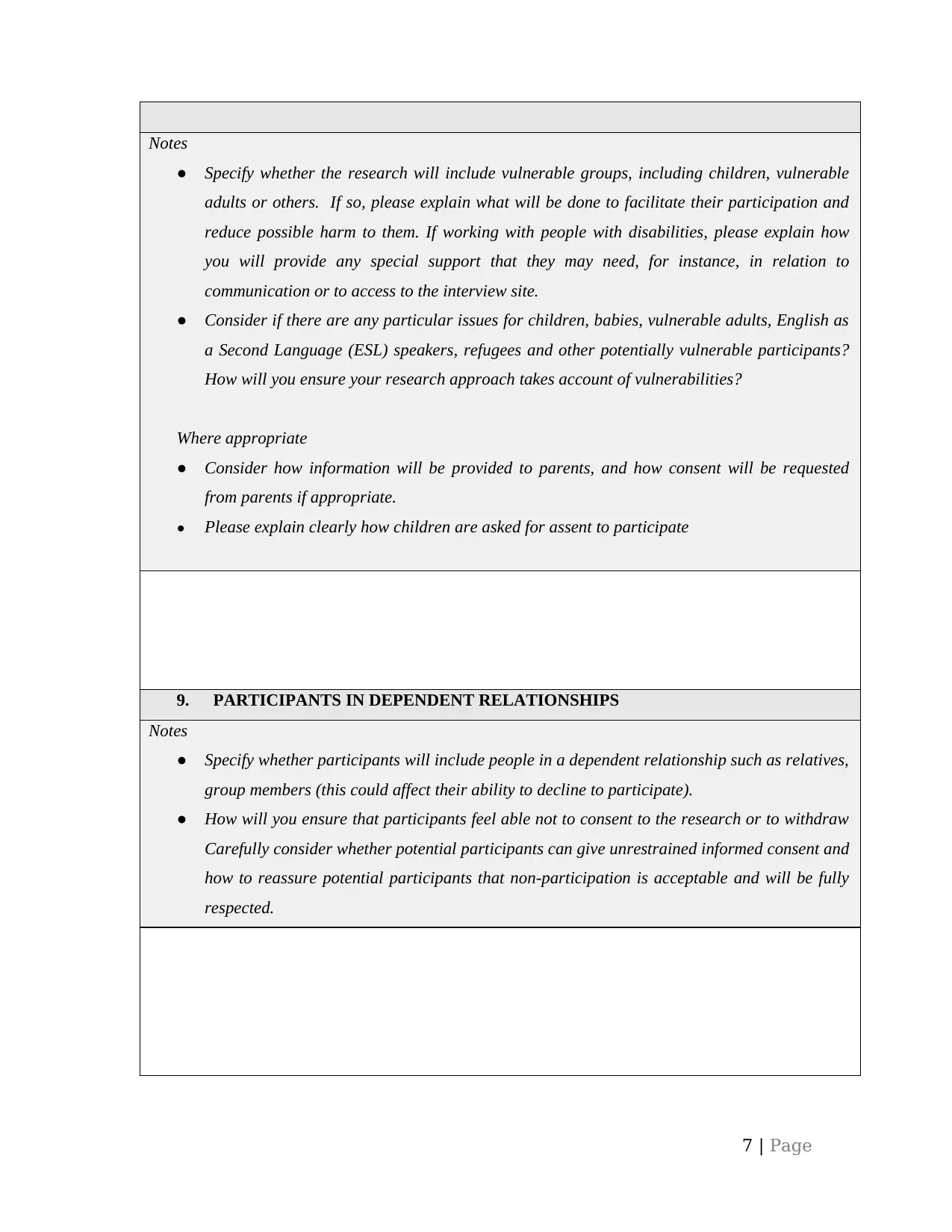
Notes
● Specify whether the research will include vulnerable groups, including children, vulnerable
adults or others. If so, please explain what will be done to facilitate their participation and
reduce possible harm to them. If working with people with disabilities, please explain how
you will provide any special support that they may need, for instance, in relation to
communication or to access to the interview site.
● Consider if there are any particular issues for children, babies, vulnerable adults, English as
a Second Language (ESL) speakers, refugees and other potentially vulnerable participants?
How will you ensure your research approach takes account of vulnerabilities?
Where appropriate
● Consider how information will be provided to parents, and how consent will be requested
from parents if appropriate.
● Please explain clearly how children are asked for assent to participate
9. PARTICIPANTS IN DEPENDENT RELATIONSHIPS
Notes
● Specify whether participants will include people in a dependent relationship such as relatives,
group members (this could affect their ability to decline to participate).
● How will you ensure that participants feel able not to consent to the research or to withdraw
Carefully consider whether potential participants can give unrestrained informed consent and
how to reassure potential participants that non-participation is acceptable and will be fully
respected.
7 | Page
● Specify whether the research will include vulnerable groups, including children, vulnerable
adults or others. If so, please explain what will be done to facilitate their participation and
reduce possible harm to them. If working with people with disabilities, please explain how
you will provide any special support that they may need, for instance, in relation to
communication or to access to the interview site.
● Consider if there are any particular issues for children, babies, vulnerable adults, English as
a Second Language (ESL) speakers, refugees and other potentially vulnerable participants?
How will you ensure your research approach takes account of vulnerabilities?
Where appropriate
● Consider how information will be provided to parents, and how consent will be requested
from parents if appropriate.
● Please explain clearly how children are asked for assent to participate
9. PARTICIPANTS IN DEPENDENT RELATIONSHIPS
Notes
● Specify whether participants will include people in a dependent relationship such as relatives,
group members (this could affect their ability to decline to participate).
● How will you ensure that participants feel able not to consent to the research or to withdraw
Carefully consider whether potential participants can give unrestrained informed consent and
how to reassure potential participants that non-participation is acceptable and will be fully
respected.
7 | Page
Paraphrase This Document
Need a fresh take? Get an instant paraphrase of this document with our AI Paraphraser
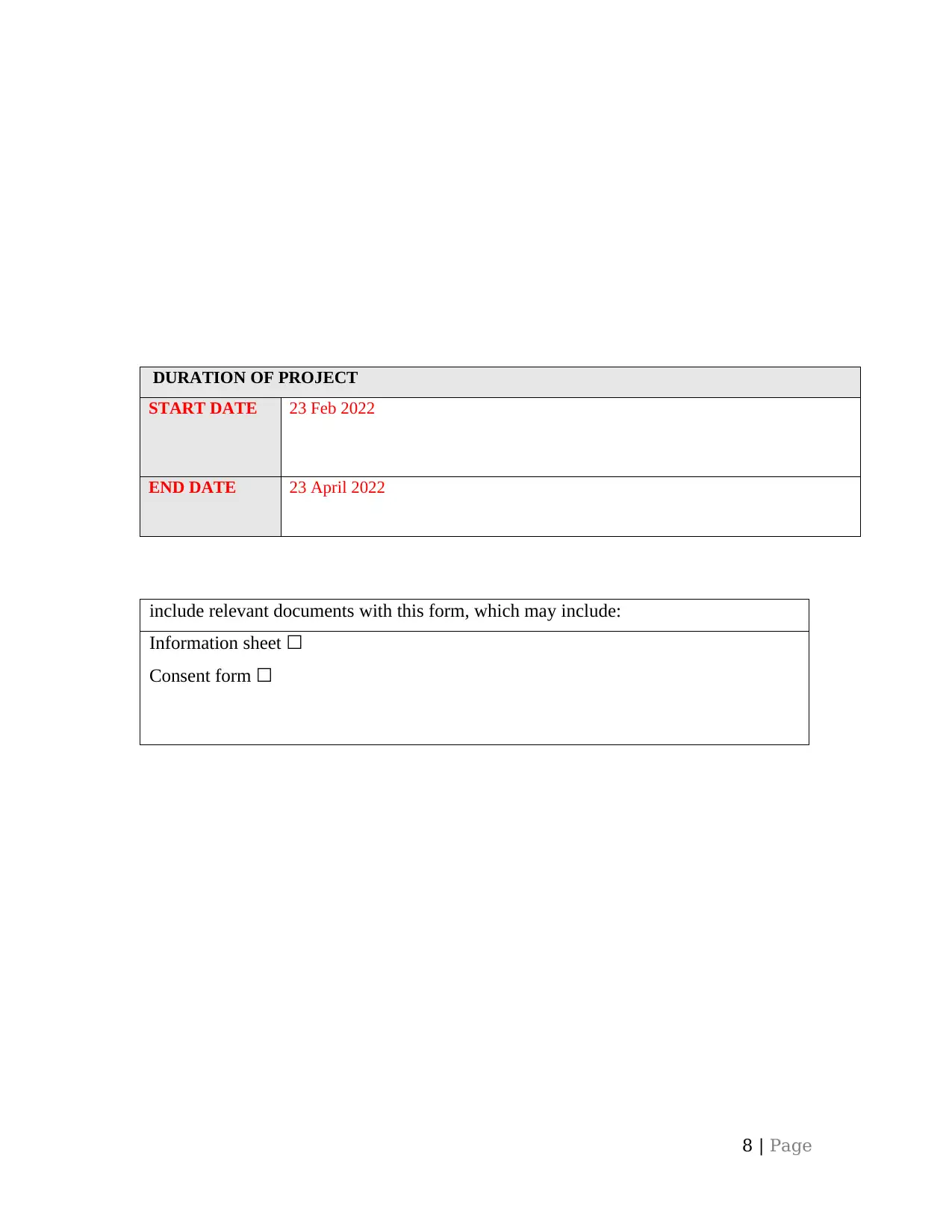
DURATION OF PROJECT
START DATE 23 Feb 2022
END DATE 23 April 2022
include relevant documents with this form, which may include:
Information sheet ☐
Consent form ☐
8 | Page
START DATE 23 Feb 2022
END DATE 23 April 2022
include relevant documents with this form, which may include:
Information sheet ☐
Consent form ☐
8 | Page
1 out of 8
Related Documents
Your All-in-One AI-Powered Toolkit for Academic Success.
+13062052269
info@desklib.com
Available 24*7 on WhatsApp / Email
![[object Object]](/_next/static/media/star-bottom.7253800d.svg)
Unlock your academic potential
Copyright © 2020–2025 A2Z Services. All Rights Reserved. Developed and managed by ZUCOL.





